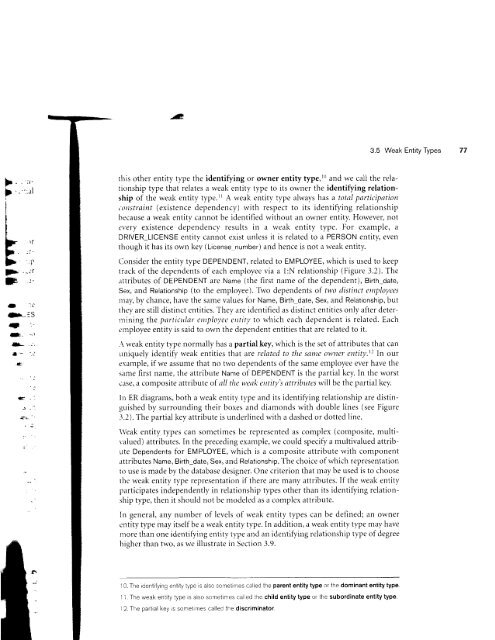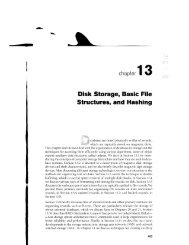this pdf excerpt
this pdf excerpt
this pdf excerpt
Create successful ePaper yourself
Turn your PDF publications into a flip-book with our unique Google optimized e-Paper software.
lr. - ;ip'.-::.rl<br />
hh F*<br />
F<br />
|<br />
)r<br />
-ll 'r<br />
.)r<br />
-t-<br />
-.c<br />
ryl:S<br />
t:-<br />
F- "1<br />
I-<br />
,l! -<br />
,&<br />
'r--'<br />
.,"<br />
-.J<br />
G ---<br />
]fi!,-_<br />
l:<br />
.G<br />
<strong>this</strong> other entity type the identifying or owner entity type,r') and we cirli the relationship<br />
type that relates a weak entity type to its owner the identifing relationship<br />
of the weirk entity type.rr A ll'eak entity type always has a total participtrtion<br />
.onstraint (existence dependency) rvith respect to its identifying relationsl,ip<br />
because a weak entity cannot be identified without an owner entity. However, not<br />
r'\.ery existence ciependency results in a weak entity tvpe. For example, ir<br />
DRIVER_LICENSE entity cannot exist Lrnless it is related to a PERSON entity, even<br />
thor-rgh it has its orvn key (License number) and hence is not a rveak entity.<br />
Consider the er-rtity type DEPENDENT, related to EMPLOYEE, which is used to keep<br />
track of the deprendents of each employee via a 1:N relationship (Figure 3.2). The<br />
rttributes of DEPENDENT are Name (the first name of the dependent), Birth_date,<br />
Sex, and Relationship (to the ernployee). Two dependents of two distirrct employees<br />
nray, by chance, have the same values ftlr Name, Birth date, Sex, and Relationship, but<br />
they are still distinct entities. They are identified as distinct entities only after deterrrrirring<br />
the particulttr enrployee ctrtif t, to rvhich each dependent is related. Eacl-r<br />
r'rnployee entit,y is said to own the dependent entities that are related to it.<br />
.\ weak entity type normally has a partial key, which is the set of attributes that car.r<br />
ur-riquely identiff weak entities that are related to the sanrc owner entity.lr In our<br />
erample, if we assume that no two dependents of the same employee ever have the<br />
same first name, the attribute Name of DEPENDENT is the partial key. In the worst<br />
cirse, a composite irttribute of all tlrc wcak errtity's ottributes rvill be the partial key.<br />
In ER diagrams, both a weak entit,v tvpe and its identif,ving relationship are distinguished<br />
by surrounding their boxes and diamonds with clouble lines (see Figure<br />
-1.2). The partial key attribute is underlined with a dashed or dotted line.<br />
\\'eak entity types can sometimes be represented as complex (composite, multivaiued)<br />
attributes. In the preceding exan'rple, we could specity a multivalued attribr.rte<br />
Dependents for EMPLOYEE, which is ir composite attribute with component<br />
attributes Name, Birth_date, Sex, and Relationship. The choice of rvhich l'epresentatiorl<br />
to use is made b,v the database designer. One criterion that may be used is to choose<br />
tl-re weak entity type representation if there are many attributes. If the weak entity<br />
participates independently in relationship types other than its identif ing relatiirrtship<br />
type, then it should not be modeled as a complex attribute.<br />
In general, any number of levels of weak entity types can be defined; an owner<br />
e ntity type may itself be a weak entity tvpe. In addition, a wezrk entity type may have<br />
nrore than one identifring entit,v type sncl an iclentifying relationsl-rip type of clegree<br />
higher than two, as we illustrate in Section 3.9.<br />
10. The identifying entity type is also somet mes called the parent entity type or the dominant entity type<br />
I 1. The weak entity type is also sometimes ca ed the child entity type or the subordinate entity type,<br />
12, The oarlial kev rs somet mes called the discriminator.<br />
3.5 Weak Entity Types<br />
77














